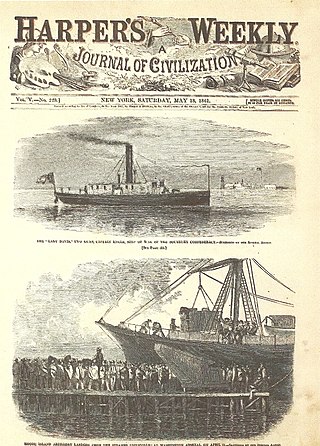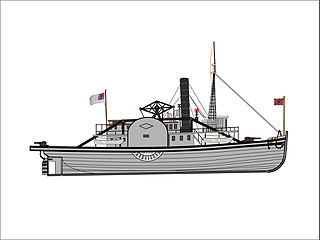
The Confederate States Navy (CSN) was the naval branch of the Confederate States Armed Forces, established by an act of the Confederate States Congress on February 21, 1861. It was responsible for Confederate naval operations during the American Civil War against the United States's Union Navy.

The Confederate States Marine Corps (CSMC), also referred to as the Confederate States Marines, was a branch of the Confederate Navy during the American Civil War. It was established by an act of the Provisional Congress of the Confederate States on March 16, 1861. The Corps' manpower was initially authorized at 45 officers and 944 enlisted men, and was increased on September 24, 1862, to 1,026 enlisted men. The organization of the Corps began at Montgomery, Alabama, and was completed at Richmond, Virginia, when the capital of the Confederate States was moved to that location. The headquarters and main training facilities remained in Richmond throughout the war, located at Camp Beall on Drewry's Bluff and at the Gosport Shipyard in Portsmouth, Virginia. The last Marine unit surrendered to the Union army on April 9, 1865, with the Confederacy itself capitulating to the U.S. federal government a month later.

Atlanta was a casemate ironclad that served in the Confederate and Union Navies during the American Civil War. She was converted from a British-built blockade runner named Fingal by the Confederacy after she made one run to Savannah, Georgia. After several failed attempts to attack Union blockaders, the ship was captured by two Union monitors in 1863 when she ran aground. Atlanta was floated off, repaired, and rearmed, serving in the Union Navy for the rest of the war. She spent most of her time deployed on the James River supporting Union forces there. The ship was decommissioned in 1865 and placed in reserve. Several years after the end of the war, Atlanta was sold to Haiti, but was lost at sea in December 1869 on her delivery voyage.

CSS Oregon was a wooden sidewheel steamer that served as a gunboat in the Confederate States Army during the American Civil War. Built in 1846 for the Mobile Mail Line, she transported mail between New Orleans, Louisiana, and Mobile, Alabama, before the war. In 1861, she was seized by the Governor of Louisiana, Thomas Overton Moore, and served as a blockade runner before being selected for use by the Confederate Army. After transferring men and supplies to Ship Island, she was formally converted into a gunboat and armed with four cannon. Remaining behind on Lake Pontchartrain when many Confederate warships were transferred up the Mississippi River, Oregon served in the Mississippi Sound and Pass Christian areas. She took part in several minor actions involving USS New London, two of which resulted in the Confederates moving into shallow water to avoid close-range action, and the third ending when the Confederate ships abandoned the Pass Christian area. In April 1862, Union pressure confined her and other Confederate ships to Lake Pontchartrain. Later that month, with Union forces closing in on New Orleans, Oregon was sank as a blockship. Her wreck was removed and destroyed in the early 1870s.

Commodore Josiah Tattnall was an officer in the United States Navy during the War of 1812, the Second Barbary War and the Mexican–American War. He later served in the Confederate Navy during the American Civil War.

USS Southfield was a double-ended, sidewheel steam gunboat of the Union Navy during the American Civil War. She was sunk in action against the Confederate ironclad ram CSS Albemarle during the Battle of Plymouth (1864).

William Augustin Webb was an American sailor and Mexican–American War veteran who resigned his United States Navy commission after more than 20 years of service to join the Confederate States Navy in the American Civil War. Webb was decorated for his service as Captain of the CSS Teaser, part of the James River Squadron, during the Battle of Hampton Roads (1862).

The third USS Water Witch was a wooden-hulled, sidewheel gunboat in the United States Navy during the American Civil War. She is best known as the ship fired on by Paraguay in 1855. In 1864 she was captured by the Confederate States Navy, and subsequently was taken into that Navy as CSS Water Witch.

USS Seneca was a Unadilla-class gunboat built on behalf of the United States Navy for service during the American Civil War. Seneca was outfitted with guns for horizontal fire as well as with two howitzers for bombardment of shore targets. With her crew of 84, she was assigned to the Union blockade of the Confederate States of America.

USS Varuna was a screw steamer acquired by the Union Navy during the American Civil War. Under construction in 1861, she was purchased incomplete on 31 December. After being commissioned in February 1862, she traveled to join the West Gulf Blockading Squadron. Varuna was present when Flag Officer David Glasgow Farragut led an attack against Confederate positions at Fort Jackson and Fort St. Philip on 24 April. During the action, Varuna ran ahead of the other Union ships, and was engaged in a chase with the Louisiana gunboat Governor Moore. After closing in on the Union ship, Governor Moore rammed Varuna twice, with the gunboat CSS Stonewall Jackson adding a third blow. Varuna sank within 15 minutes, but Farragut was able to capture the city of New Orleans, Louisiana.

CSSResolute was a tugboat built in 1858 at Savannah Georgia as the Ajax which served in the Confederate States Navy during the American Civil War.

CSSLady Davis was a gunboat in the Confederate States Navy during the American Civil War.

The siege of Fort Pulaski concluded with the Battle of Fort Pulaski fought April 10–11, 1862, during the American Civil War. Union forces on Tybee Island and naval operations conducted a 112-day siege, then captured the Confederate-held Fort Pulaski after a 30-hour bombardment. The siege and battle are important for innovative use of rifled guns which made existing coastal defenses obsolete. The Union initiated large-scale amphibious operations under fire.

The Battle of Port Royal was one of the earliest amphibious operations of the American Civil War, in which a United States Navy fleet and United States Army expeditionary force captured Port Royal Sound, South Carolina, between Savannah, Georgia and Charleston, South Carolina, on November 7, 1861. The sound was guarded by two forts on opposite sides of the entrance, Fort Walker on Hilton Head Island to the south and Fort Beauregard on Phillip's Island to the north. A small force of four gunboats supported the forts, but did not materially affect the battle.

The Battle of Forts Jackson and St. Philip was the decisive battle for possession of New Orleans in the American Civil War. The two Confederate forts on the Mississippi River south of the city were attacked by a Union Navy fleet. As long as the forts could keep the Federal forces from moving on the city, it was safe, but if they fell or were bypassed, there were no fall-back positions to impede the Union advance.

USS Unadilla was a Unadilla-class gunboat built for service with the United States Navy during the American Civil War. She was the lead ship in her class.
USS Vixen was acquired by the Union Navy from the United States Coast Survey on 26 August 1861 for use as a reconnaissance vessel during the American Civil War; and was later commissioned on 31 July 1862.

USS Isaac Smith was a screw steamer acquired by the United States Navy during the American Civil War. She was used by the Union Navy to patrol navigable waterways of the Confederate States of America to prevent the Confederacy from trading with other countries. In 1863, she became the only warship in the American Civil War to be captured by enemy land forces. She then served in the Confederate States Navy as CSS Stono until she was wrecked.

CSS Sampson, sometimes spelled Samson, was employed as a tugboat, prior to her purchase by the Confederate Government in 1861.
CSS Pamlico was a sidewheel steamer that served in the Confederate States Navy during the early stages of the American Civil War. Originally a passenger vessel on Lake Pontchartrain, she was purchased by Confederate authorities on July 10, 1861, and converted into a gunboat. She participated in two minor naval actions in the vicinities of Horn Island and Ship Island in December, before taking part in two more small battles defending the Pass Christian area in March and April 1862. In late April, Union Navy ships passed the defenses of New Orleans, Louisiana. After ferrying Confederate troops out of the city, Pamlico was burned by her crew on Lake Pontchartrain on April 25 to prevent capture.

















